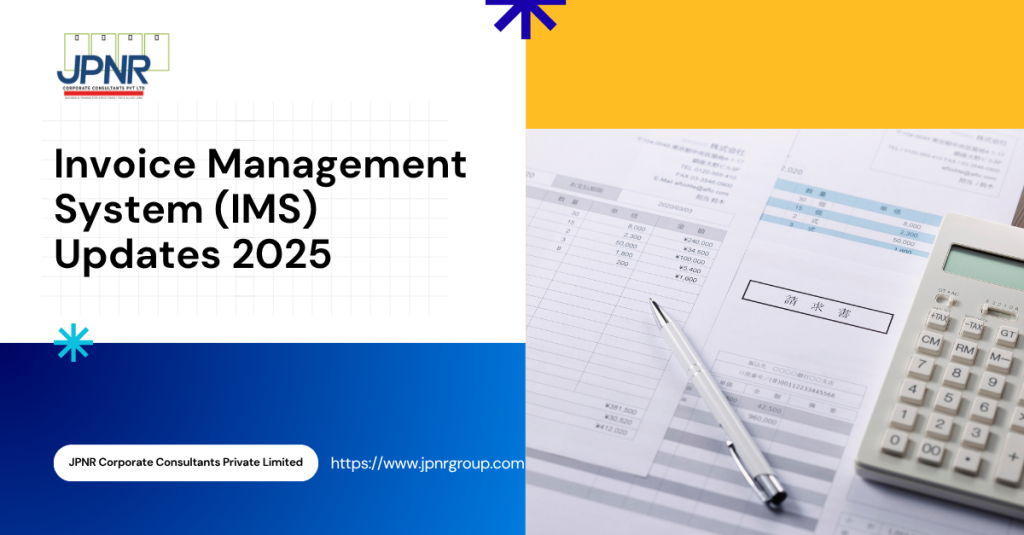
What Is the Invoice Management System (IMS)?
The Invoice Management System (IMS) is a dedicated module within the GSTN (Goods and Services Tax Network) portal. It allows recipient taxpayers to accept, reject, or mark invoices and credit/debit notes as pending before claiming Input Tax Credit (ITC). In simple terms, IMS helps businesses verify the accuracy of invoices uploaded by their suppliers before they claim any ITC on them. This process ensures that only genuine and validated transactions are used for tax credit purposes. IMS is directly integrated with GSTR-2B, a static statement that gives a consolidated view of all supplier-uploaded invoices. This integration helps businesses reconcile their purchase data, identify mismatches early, and maintain accurate ITC records. Although IMS has been part of the GST system for some time, the October 2025 upgrade introduces new flexibility and greater control for taxpayers, making invoice management more transparent, efficient, and compliant.Key IMS Changes for GST 2025: October Updates
From October 2025, the Government has rolled out important Invoice Management System (IMS) updates to simplify invoice tracking, improve Input Tax Credit (ITC) accuracy, and strengthen overall GST compliance for businesses. Here’s a breakdown of the key changes:1. Option to Keep Records Pending in IMS
One of the most impactful updates is the introduction of the “Pending” status in IMS. This feature allows taxpayers to keep specific documents pending for review, instead of making immediate decisions. The pending period lasts one tax period for monthly filers and one quarter for quarterly filers, providing flexibility for businesses of all sizes. The pending option applies to credit notes, downward invoice amendments, and e-commerce operator (ECO) documents. It gives businesses extra time to validate supplier data before finalizing ITC claims, reducing reconciliation errors and helping maintain more accurate tax records.2. Precise ITC Declaration & Partial Reversal
The updated IMS enhances how taxpayers declare and reverse ITC. Businesses can now specify the exact ITC amount for each document and reverse only the relevant portion when needed. If no ITC has been claimed, no reversal is required. This ensures accurate ITC management, cleaner books, and fewer excess reversals. It also supports better transparency in ITC reconciliation, reduces disputes during assessments, and aligns businesses with the new GST rules for 2025.3. Add Remarks for Better Transparency
Another useful feature is the ability to add remarks when marking a document as “Rejected” or “Pending”. These remarks are visible to both the recipient in GSTR-2B and the supplier on their dashboard. This two-way visibility improves communication, trust, and accountability between suppliers and recipients. Clear documentation simplifies GST audits and invoice reconciliations, minimizing confusion and disputes.4. GSTR-2B Auto-Population Remains Unchanged
Despite these enhancements, the GSTR-2B auto-population process continues as before. The GSTR-2B will still be generated on the 14th of every month, allowing taxpayers to review supplier invoices before filing GSTR-3B. Businesses can also take action within IMS and regenerate GSTR-2B as needed. This ensures a stable workflow while adding control and visibility, helping businesses stay GST-ready, minimize errors, and manage compliance more efficiently.Impacts and Benefits
Key Benefits:
- More flexibility in invoice validation: Mark invoices or credit/debit notes as “Pending” to review before accepting or rejecting.
- Precise ITC reversal: Reverse only the portion of Input Tax Credit (ITC) actually claimed, reducing over-reversals.
- Improved transparency: Optional remarks visible to both supplier and recipient enhance communication and reduce disputes.
- Stronger audit trail: Clear tracking of actions supports easier GST reconciliation and audit readiness.
Key Challenges:
- ERP and accounting updates required: Systems may need modifications to handle the new IMS workflow.
- Timely tracking of pending invoices: Businesses must monitor pending documents within the allowed period.
- Accurate ITC reconciliation essential: Partial reversals and pending statuses require careful management to maintain compliance.
Conclusion
The new IMS updates from October 2025 make managing GST much easier and more transparent for businesses. With features like the “Pending” option, precise ITC reversal, and the ability to add remarks, you now have more control over your invoices and tax records.These changes help reduce errors, improve communication with suppliers, and make audits less stressful. While it does require keeping an eye on pending invoices and updating accounting systems, the benefits clearly outweigh the extra effort. Overall, the upgraded IMS makes GST compliance simpler, smoother, and more reliable for everyone.
Frequently Asked Questions
The October 2025 IMS updates include the new Pending option for invoices, precise ITC declaration and partial reversal, the ability to add remarks for transparency, and continued GSTR-2B auto-population.
The Pending option lets taxpayers hold invoices or credit notes for review before accepting or rejecting them. It provides additional time to verify supplier data, thereby reducing ITC mismatches and enhancing compliance accuracy.
Yes, some ERP and accounting systems may need updates to support the new IMS workflow, including tracking pending invoices, partial ITC reversals, and integration with GSTR-2B data.
Businesses should update their accounting software, train staff on the new IMS features, track pending invoices regularly, and reconcile ITC data carefully to stay compliant with the new GST rules.



Would you like to share your thoughts?